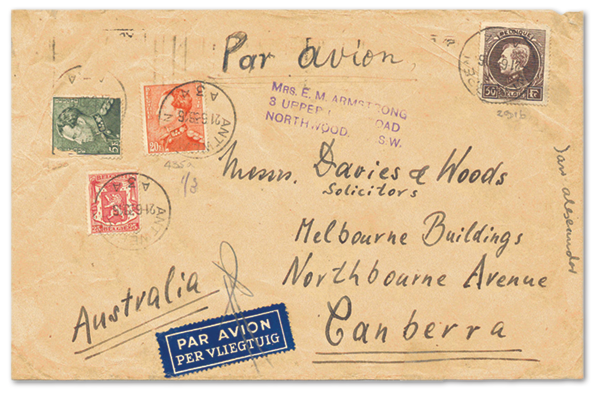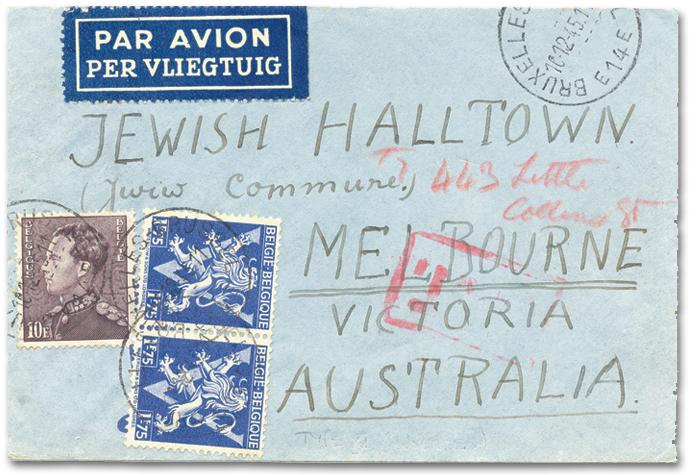With the advent of longer distance airmail routes during the latter part of the 1920s and into the 1930s, higher value definitives were required than had been available hitherto. 5 & 10 Fr values of both the small Montenez and Houyoux issues were 6-8 years old, but were quite adequate for letter and packet rates by sea without using excessive stamps.
Figure 1. Houyoux and small Montenez stamps
Few examples of internal use exist for the new stamps, since the face values were mostly too high. Registration was one such use.
Albert 1 died in February 1934, which immediately meant that both the large Montenez and Kepi issues had a finite life. However, the large Montenez series was issued up to 1941, but only in different shades, save the addition of the 100 Fr value in 1939. The Poortman issue was the first definitive series from Leopold’s reign. Again, the values issued in 1936 only varied in shade until some of the same values and two new values were re-issued in 1951, and then all p 11½, rather than p14 as previously.
An example of the three issues, which concern us, is shown below.
Fig 2. June 1939 airmail letter from Antwerp to Canberra using a 50 Fr Montenez with 5 & 20 Fr Poortman stamps. Total weight was 50-55 gms for a cost of 7525 Fr. Postage 175 (≤ 20 gm) + 2 (21< gm ≤ 60) = 375 Fr, air 11 x 650 (per 5 gm) = 7150 Fr
Fig 3. December 1931 registered internal letter at Grivegnée using a 175 Fr Képi stamp to pay registration of the total of 225 Fr. Postage 75c (State Lion), registration 175 Fr (1 & 125 Fr Képi stamps existed for this rate)
Fig 4. March 1934 express letter from Brussels to Vienna using 3 se-tenant 175 Fr blue stamps for a total of 525 Fr. Postage 175 Fr, express fee 350 Fr
As the above letter was posted on a Friday, it probably would have been delivered in Vienna on Monday at ordinary rates. Backstamps show it reached Vienna GPO on Saturday and Vienna 57 on Sunday morning. There being no Sunday delivery, it then sat for 24 hours.
Fig 5. June 1936 double airmail rate letter from Turnhout to Bombay with 175, 2 & 5 Fr Képi stamps. Postage 175 Fr, airmail 7 Fr (≤ 10 gm) for 875 Fr franking (a year earlier the airmail rate was 5 Fr per 5 gms, now it was 350 Fr)
An identical letter, which had been posted three months earlier from Turnhout, flew directly to Bombay. Then the airmail sticker was “Cancelled Bombay 27 Mar 36” and the backstamps corroborate this by their dates. This time the letter only flew to Karachi – see cancellation over the “par Avion” – and then went by train to Bombay probably via Agra. Again the backstamp dates confirm the 3-4 days elapsed between Karachi and Bombay for a train trip.
Did the plane experience trouble, which might have required the mail to be offloaded or, had the London-Singapore route changed during that period, eliminating Bombay, so that Bombay letters were offloaded at Karachi as standard? After all, a weekly service between London and Australia commenced in December 1934 flying Karachi to Rangoon.
By 1933, Air France flew weekly from Paris to Saigon (then capital of French Indo-China). Backstamps (see cover below) show 3 Nov Brussels, 7 Nov Paris Ro Avion with a slogan Gagnez du temps – répondez par avion (save time – reply by airmail) and 22 Nov Hong Kong. The flight would have taken around 6-7 days to reach Saigon. I assume the letter then went by boat to Manila from Saigon and possibly also via Singapore on its way. Delivery in Manila would have been around 24-25 November, thus the letter took just over three weeks, which was still faster than sea mail. The world was beginning to shrink.
Fig 6. November 1934 double airmail rate letter from Antwerp to Manila with a pair of 2 Fr and a 5 Fr Kepi stamps Postage 175 Fr, airmail 9 Fr (≤ 10 gm) for 1075 Fr franking
Fig 7. Triple airmail rate letter from Antwerp to Johannesburg using 150 magenta, 175 marine blue, 2 red-violet & 10 Fr brown-violet stamps Postage 175 Fr, airmail 1350 Fr
The issue of Leopold III engraved by Maurice Poortman probably has been Belgium’s most popular issue of all time. First issued during 1936, it is legal today. The first values ceased printing after 1943 (except 5, 10 & 20 Fr).
From 1951, with the installation of a Swiss Wifag press, new values with 11½ perforation were printed until 1968. The last stamp was issued to commemorate Leopold’s death in 1983. Leopold had abdicated in favour of his son, Baudouin, in 1951, just before Baudouin achieved his majority. It was remarkable that the Poortman stamps lasted so long into Baudouin’s reign.
Fig 8. Double airmail rate letter from Antwerp to Sydney mailed Jan 1940 using a pair of 2 Fr lilac and a 10 Fr brown violet stamps Postage 175 Fr, airmail 13 Fr
Fig 9. Dec 45 OAT (type XI) endorsed airmail letter from Brussels to Melbourne. Using a 10 Fr brown-violet and a pair of 175 Fr Liberation Lion stamps. Postage 350 Fr, airmail 10 Fr
The 20 Fr went through three shades just after WW2, these being light orange (1946), yellow orange (1948) and vermilion-red (1949-1953). The last two are fairly rare on cover. The 10 Fr also changed shades twice after the war, but being a lower value, was used more frequently.
One letter is shown with the OAT (onward air transmission) marking. This mark is thought to be a ‘sleeper’, i.e. it appears on the top letter of a bundle only, since only some 2600 are known worldwide. They all used red ink. The bulk of OAT markings were applied in London during 1945-46, but their use is known from 1940-1954. The mark was not UPU approved. USA was a common destination, Australia & New Zealand were rare.
From 1951, with the installation of a Swiss Wifag press, new values with 11½ perforation were printed until 1968. The last stamp was issued to commemorate Leopold’s death in 1983. Leopold had abdicated in favour of his son, Baudouin, in 1951, just before Baudouin achieved his majority. It was remarkable that the Poortman stamps lasted so long into Baudouin’s reign.
Fig 10. March 1948 double airmail rate letter from Brussels to Sydney with yellow-orange 20 Fr stamp. Postage 315 Fr (reduced by 10% to 315 Fr on 20 May 46), airmail 20 Fr
The 20 Fr went through three shades just after WW2, these being light orange (1946), yellow orange (1948) and vermilion-red (1949-1953). The last two are fairly rare on cover. The 10 Fr also changed shades twice after the war, but being a lower value, was used more frequently.
One letter is shown with the OAT (onward air transmission) marking. This mark is thought to be a ‘sleeper’, i.e. it appears on the top letter of a bundle only, since only some 2600 are known worldwide. They all used red ink. The bulk of OAT markings were applied in London during 1945-46, but their use is known from 1940-1954. The mark was not UPU approved. USA was a common destination, Australia & New Zealand were rare.
Fig 11. 1951 Double airmail rate letter from la Calamine-Neu-Moresnet to Argentina with a 20 Fr vermilion-red stamp (1949-1953). Postage 4 Fr, airmail 16 Fr La Calamine-Neu-Moresnet is in an area of Belgium, which was ceded by Germany in 1919
While Australia & UK were at war with Germany, Germany only invaded Belgium 1 May 1940. Hence, mails from Belgium travelled freely to Australia and were censored in Sydney – see the two red dots.
OAT (onward air transmission) markings occur between 1940 and 1954. The bulk occurred 1945-1946. They were never an approved UPU instructional marking but were used to facilitate expedition of fully paid airmail rate to destination letters and postcards. Two airmail rates existed then; one by air all the way and a second, which was part air and part seamail. Some of the early usages occurred in Tangier, Cairo and Prestwick to assist London during the Blitz. Later they all moved to London.
The relative scarcity of these markings suggests that they were a “sleeper”, i.e. used on the top item in a bundle of mail to a common destination (usually of 60 items). Some 2500 items have been recorded by Heifetz (OAT & AV Markings, Canada 2001) comprising 20 different handstamps. Nearly all used red ink.
Fig 12. 18 March 1952 registered airmail letter from Grivegnée to Belgian Congo with 10 Fr brown-grey (p11½*) stamp postage 3 Fr (preferential Congo rate – normal 4 Fr), registration 4 Fr, airmail 3 Fr. Letter returned as addressee had returned to Belgium (backstamps of 20 & 27 March of Leopoldville)
The USA was a common destination, Australia and New Zealand rare ones. However, at the end of the war in Europe, there was a relatively small number of ex-concentration camp Jews, who were anxious to contact either relatives or the Jewish Welfare Committee in Melbourne with a view to immigrating to Australia. The farther they were from the horrors of Europe the better. The same problems exist today for other peoples.
Despite the chaotic conditions in Europe late 1944 (partial liberation) till late 1945 (VE Day was 7 May), the mails mostly were correctly charged for airmail.
Special postage and airmail rates have long existed between Belgium and the Belgian Congo (before 1960 independence). This was partly due to volumes but also as a means of subsidy.
* It was only after the commissioning of the first Wifag press by Belgium in 1951, that stamp perforations changed from 14 to 11½. This last letter (see figure 12) is the only example shown using a Poortman stamp printed on the new press.
By 1952 postage and registration had essentially only doubled since 1930, airmail rates had effectively declined, so that 10 Fr for the above letter no longer required a truly high value stamp.



















Collectors of Belgium and Colonies should join the Belgian Study circle by visiting http://www.belgiumstamps.org.uk/.